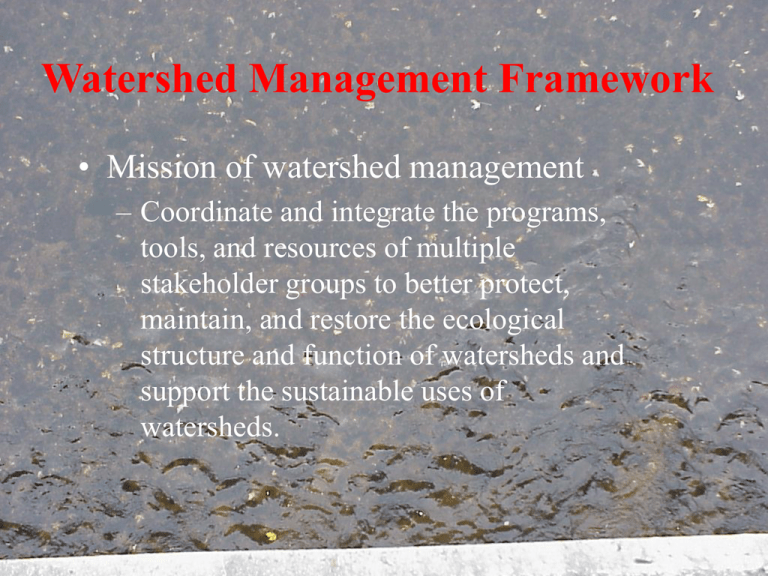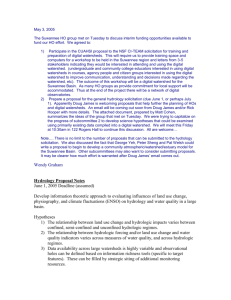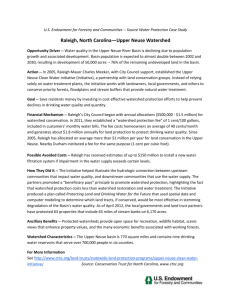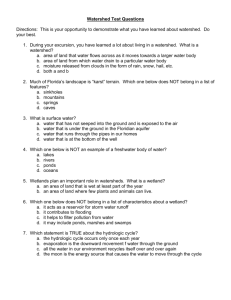Watershed Management Framework
advertisement

Watershed Management Framework • Mission of watershed management – Coordinate and integrate the programs, tools, and resources of multiple stakeholder groups to better protect, maintain, and restore the ecological structure and function of watersheds and support the sustainable uses of watersheds. Form Interagency Workgroup • Design and implement a framework to facilitate the transition from a programcentered to a resource-based approach to holistic management of watershed. Resource Management Goals • Conserve and enhance public health. • Conserve and enhance watershed ecosystems. • Support watershed resource use to achieve water quality standards and conservation goals. • Conserve and improve ambient conditions. • Reduce or prevent pollutant loadings and other stressors. Goals Achieved Through Operational Objectives • Identify indicators of watershed integrity to – Support sound, scientific assessments of watershed resources and – Establish watershed management priorities to guide integrated efforts Goals Achieved Through Operational Objectives • Increase communications and consensus among state programs and other stakeholder groups to – improve understanding of watershed ecosystems, – Strengthen information and data exchange – Share expertise and tools, and – Develop and implement integrated solutions Goals Achieved Through Operational Objectives • Implement integrated solutions by coordinating activities on targeted watersheds or problem areas within watersheds – Regulatory activities (standards, permitting, monitoring, enforcement, and federal reporting) and – Non-regulatory activities (planning, technical assistance, and outreach) Goals Achieved Through Operational Objectives • Provide a forum for program networking to – Manage changes in program funding, – Leverage and share common resources, and – Help obtain increased support Goals Achieved Through Operational Objectives • Develop stronger partnerships with regional, county, and local governments to – Better incorporate best management practices and – Address multiple resource management objectives within watersheds Goals Achieved Through Operational Objectives • Coordinate public communication and education forums, • Coordinate existing means and develop new avenues for individual and group participation in watershed management, and • Promote stronger resource conservation ethics Major Elements – Stakeholder involvement • Stakeholders include – Any agency, organization, or individual that has an interest in watershed management. • • • • State agencies Federal agencies Local government NGO’s (non-governmental organizations – Chamber of Commerce, Sierra Club, Waterways Alliance – Avenues for public participation include • • • • public forums, monitoring, plan development and review, and Implementation Major Elements – Basin-wide management units – Large-scale basins, • Resource units to focus – monitoring – management strategies • Framework to coordinated stakeholders to better utilization of resources – tax dollars, – time, – information. Hydrologic Units Click on map for definition of units, go to Region 5 for most of Indiana watersheds Gauging Station • Lafayette, Indiana Major Elements – Statewide basin management cycle • Scoping and information gathering (monitoring) – Includes communication of current status of basin to the public and – Collecting additional information on the condition of the basin as a basis for the watershed priority formula. Montgomery Reservoir, Clearfield, PA Water Company Major Elements – Statewide basin management cycle • Basin assessment - Data analysis and summary. • Prioritization and targeting of resources – – Develop formula to be an interagency tool for prioritizing watersheds within a basin for further action • Based upon a rating system that considers – human health and – ecological health for both restoration and protection goals. • Provide basis for decision making and targeting of program resources. Tippecanoe River, Pulaski, IN Major Elements – Statewide basin management cycle • Development of management strategies and plans – – The basin management plan will serve as the document for • summarizing information on the basin, • documenting proposed strategies for addressing problems, and • communicating to the public the status of watersheds. West Branch Susquehana River, Clearfield, PA Major Elements – Statewide basin management cycle • Implementation – – A "tool box" of implementation activities is prepared – Serves as resource for addressing various environmental problems Major Elements – Statewide basin management cycle – tool kit NRCS Conservation Reserve Program Conservation Reserve Enhancement Program Major Elements – Statewide basin management cycle – tool kit Wildlife Habitat Incentives Program Wetland Reserve Program Forestry Best Management Practices Agriculture Best Management Practices Slump in Humuya Watershed, Honduras, C.A. Benefits of Watershed Approach • More direct focus on the resource to be protected, tailored to the region- and basin-specific problems and conditions that may be present • Coordination among programs and agencies that perform similar duties, thus stretching tax dollars and man-power • Improved capabilities to address complex environmental issues that cross agencies' jurisdictions Polk County Oregon Benefits of Watershed Approach • Improved basis for management decisions as better coordination of monitoring is established and more information is gathered on a specific basin • Consistency and continuity is encouraged as an initial framework is prepared and applied evenly to all basins in a systematic and sequential fashion • Opportunities for data sharing enhanced as agencies and organization improve communication and coordination Muscatatuck Restoration Benefits of Watershed Approach • Enhanced public involvement as agency solicits stakeholder input and participation • Encouragement of innovative solutions with input from the various stakeholders, especially at the local level Missouri River overflow area






